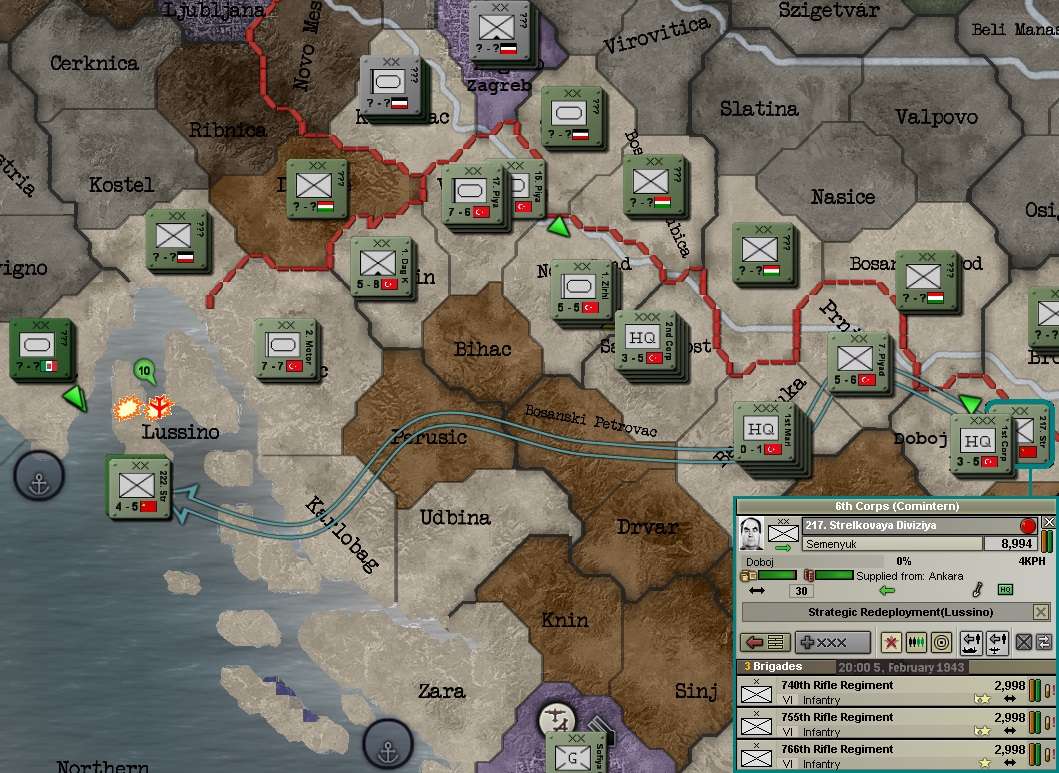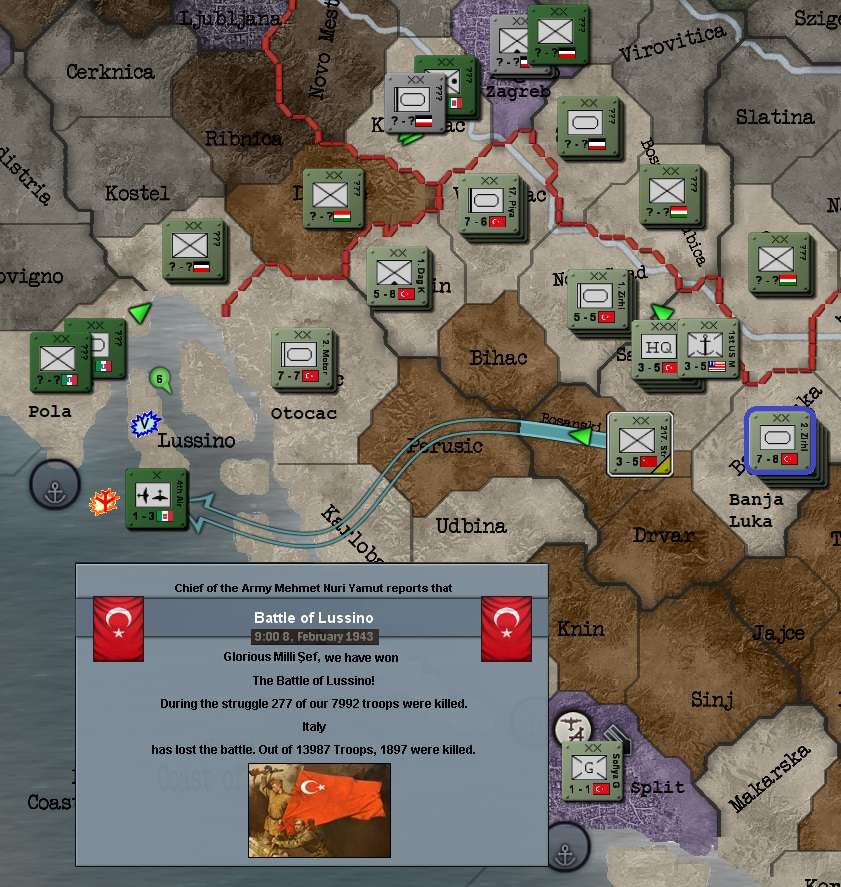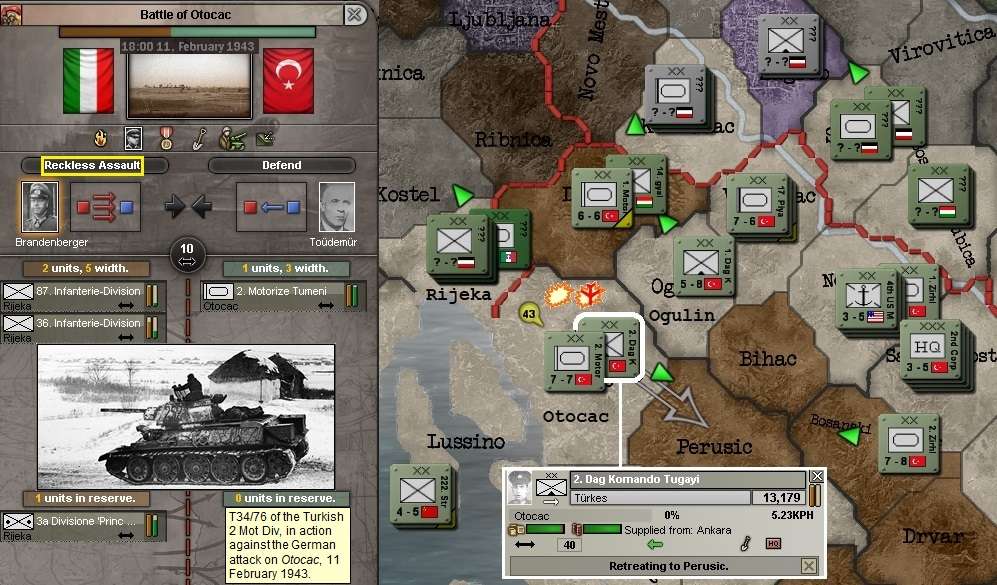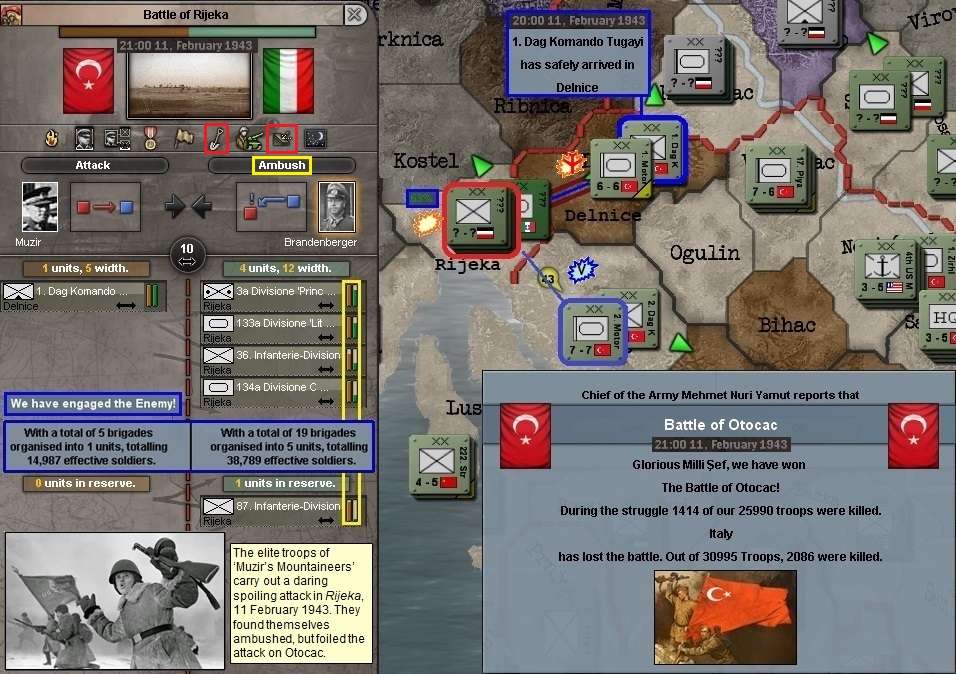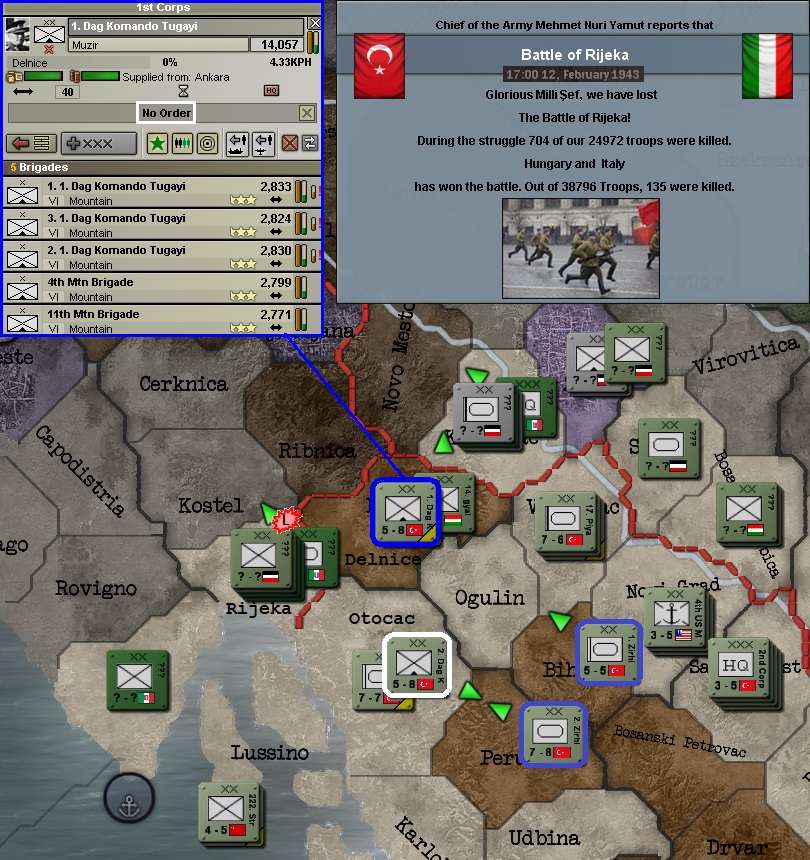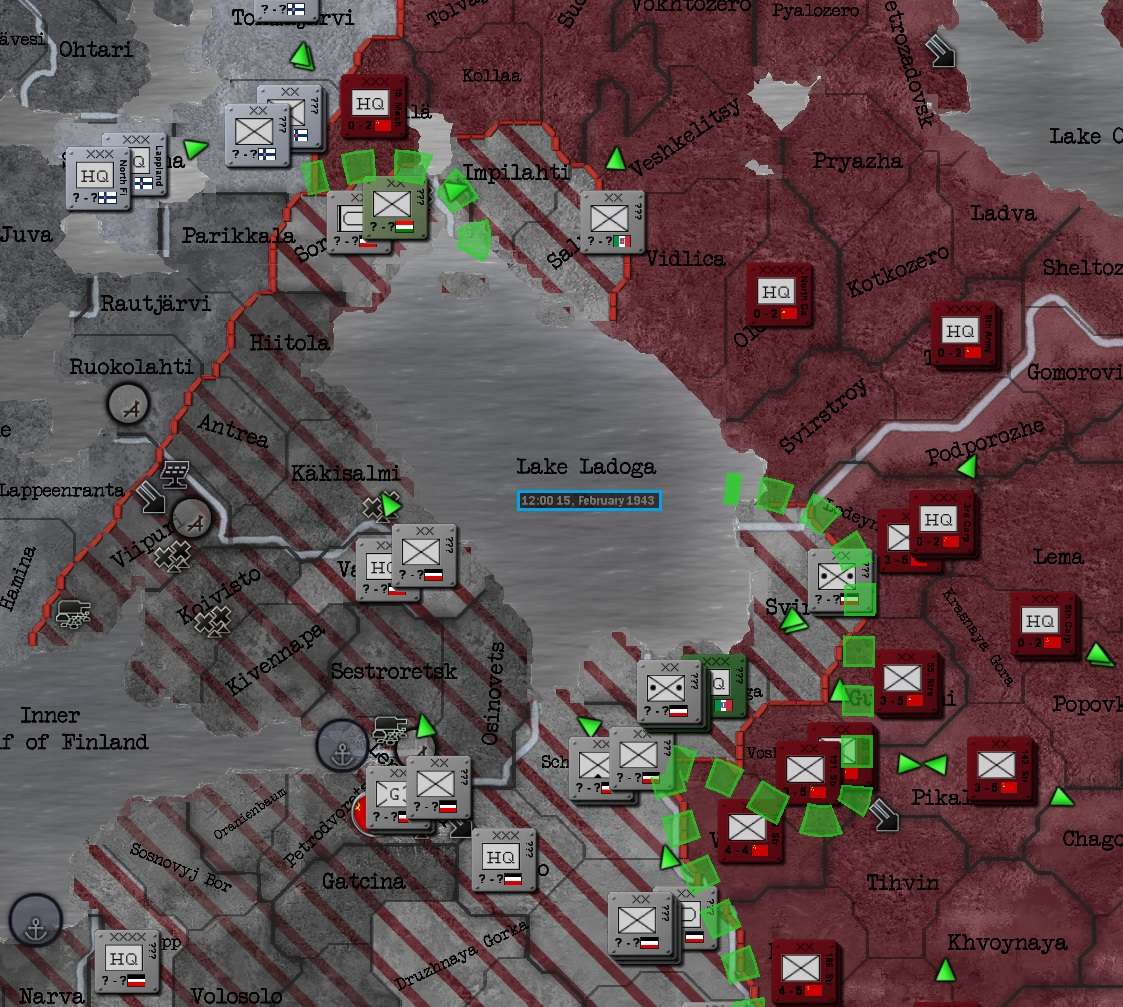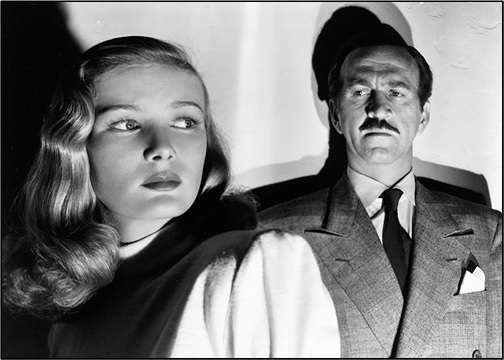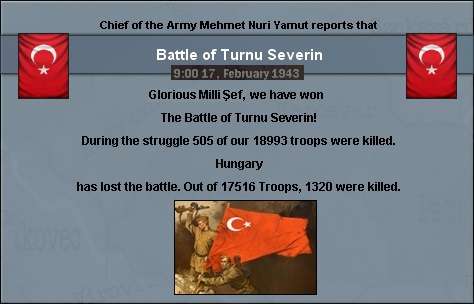Chapter 193: Shock Absorber (1 to 18 February 1943)
AuthAAR’s Note: February was played through to its end, but while there was too much for it to be crammed into one episode with the inclusion of the usual monthly reports, it will fit comfortably into two. This one covers the first two-thirds of the month, the next the last plus reports. @Wraith11B, watch out for the first appearance of a certain in-game character. And I’m sure @diskoerekto will advise if my Google translated Turkish phrase is in need of correction! 
---xxx---
Recap. January had proven to be a month of onslaughts. First, the closing out of the Adriatic Pocket, which had seen two more German divisions surrender, then consistent Axis counter-attacks, plus a breakout that had captured
Leningrad and then spread north around
Lake Ladoga. The key strategic uncertainty remained whether Finland, firmly in the Axis camp diplomatically for years now, would be tempted to actually join the Fascist pact, or continue to maintain its neutrality.
Turkey still had its tentative plans for another spring offensive, but poor weather, recovery from the
Frost Wolf winter offensive and then the persistent German-led attacks of January had those plans on hold for now.
---xxx---
1 Feb 43
The month began with a new motorised division – 3 Mot Div – being formed in
Zajecar, south of
Turnu Severin, comprising initially one of the converted militia divisions (now a MOT div) and the 4th SP Arty Bde. More brigades would be added as they became available.
The Axis obsession with
Vrnograc continued at 1 am, but a three-division probe (German, Italian and Hungarian troops) was over as soon as it began, with nine Turkish and 46 Axis soldiers killed in less than an hour.
At the same time, the Italians launched an attack across the straits from
Pola to
Lussino. The Italian armour was badly suited to the purpose (in fact were almost useless), but the infantry of their 33rd Division was far more effective. MAJGEN Devyatov of 222 SD was confident of holding, even though outnumbered. But the battle would continue for longer than the Comintern expected.
The probe earlier that morning having been quickly called off, a new attack on
Vrnograc by Italian light armour was launched at 4am. It would last for ten hours before being called off, the enemy having been handed a bloody lesson. MAJGEN Diskoerekto had found the two combats that day most instructive: he felt he had progressed to another level of efficiency.
Ground Damage Report. Axis air strikes on
Vrnograc had killed 298 Turkish defenders. The Italian Air Force would hit
Lussino up to four times a day, for the duration of the attack: total casualties there will be summarised later, but the drain on the Soviet defenders there was continuous.
---xxx---
2 Feb 43
Early on 2 February, as the assault and air attacks on
Lussino persisted, the readiness of the three fighters wings now based in
Split was assessed. But at this point, the were not yet strong enough to risk an interception. Devyatov’s men would have to tough it out for now.
That night, 1 Inf Div finished their repositioning move south from
Vrnograc to
Novi Grad, which would now have IS-1s on hand to oppose any further German armoured sorties across the Sava River.
---xxx---
3 Feb 43
At 4 am, 6 US Mar Div left
Novi Grad to take 1 Inf Div’s place in
Vrnograc: apart from evening things up, it was designed to give a future marine river crossing operation two axes of attack on their prospective target. The land and air attacks on
Lussino continued with surprising tenacity.
It was that morning that the US Marines’ new LO to HQ 1st Army, Major Kenny ‘Wraith’ Loggins, a raider-trained officer, arrived. He was introduced to President, Milli Şef and General Ismet Inönü.
“I’m glad you called me in, Mr President,” Loggins said after introductory pleasantries. “Good battlefield coordination between Allies is vital, of course. During the last month, the Sava Line was certainly under threat. I’m glad the US Marines were able to ride into the danger zone be of some direct assistance.”
“And it was greatly appreciated, Major,” replied Inönü graciously. “I’m sure the Marines were itching for that fight. You never know what you can do until you get up into the line, as far as you can go.”
“Yes, sir! Out along the edge is always where I burn to be. The further on the edge, the hotter the intensity.”
“Well, the 6th is being taken right into the danger zone in
Vrnograc. And there will be plenty for your brothers to do when it comes time to launch our next offensive across the Sava, whenever that may be. They will have to ride
right into the danger zone then.”
“Semper fi, sir!”
“Vur ha, Major!”
Major Kenny ‘Wraith’ Loggins in his Marine Corps enlistment photo, included with the biographical information provided to HQ 1st Army when he was transferred across as the USMC LO.
---xxx---
4 Feb 43
Another important day arrived for the Turkish Air Force when the first wing (8 AF) of licence-built P-51D Mustang multi-role fighters was deployed at the
Beograd air base that morning, to begin work-up. Another would follow in some weeks. But neither the US or Soviets were yet offering updated interceptor designs, so none were ordered yet. Instead, another ‘line militia’ division (2 x MIL, AA, AT) was ordered.
Compared to the currently serving La-5s, the Mustangs were an improvement in a number of areas
[a pity the air defence factor is apparently so badly bugged, as that would have been a nice advantage]. The new pilots and ground crew were better trained, the Mustang was 50kph faster and while its air attack was no better than the La-5, its basic small air search radar made it marginally more effective at night.
The repeated air raids (in particular) and ground combat were taking a toll on 222 SD in
Lussino. It was now down to 83.2% strength, with organisation below that. The Italian armour was suffering, but their infantry division was largely unscathed.
That evening, 6 US Mar Div arrived in
Vrnograc – which had remained quiet the last few days. Perhaps, apart from the continuing fighting in
Lussino, the Axis was now going to hunker down in the Adriatic-Sava Sector after the exertions of January?
The Turks’ Chief Meteorologist provided his latest report that evening as well. Temperatures were gradually increasing, with no muddy conditions being reported on either side of the Sava River in the designated breakthrough area or beyond it.
But while the weather conditions may now be conducive, the state of Turkish preparations was not. The Axis line was strong, with at least two divisions per province dug in behind the Sava River all the way from
Zagreb to
Beograd. And the key assault divisions were still recovering from their exertions of the month before, as was the Air Force. The ride into the danger zone would have to wait a little longer.
---xxx---
5 Feb 43
In
Ankara, Perse had been busy ensuring a new poster to follow up on the commemoration of the Glorious Union’s Foundation Day was produced and distributed throughout the Union – especially in the Balkans. Versions in the relevant local languages were made for each constituent GNR. She had been a little unsettled by events following the little ‘fishing expedition’ she had been made to conduct at the US Embassy. Kaya’s agents had asked many questions and it was difficult to tell the difference between their ‘happy’ face and their ‘threatening’ face. Mainly because they were never happy, and always threatening!
English language version.
As the Italian’s maintained their land and air assault on
Lussino, Inönü became increasingly concerned about the ability of 222 SD to hold indefinitely on its own. Their comrades from 217 SD were ordered across from
Doboj that evening, leaving one more division and the reinforced HQ 1st Corps to guard it.
6 Feb 43
At midnight, a coded Morse code message from the Turkish intelligence outpost in
Rome was received in
Zürich: the Italians had managed to put a counter-espionage team in the field and had one more in reserve, it was suspected. This team had managed to apprehend one of the Turkish spies operating in Italy, though he had been quickly replaced.
For now, their orders were to remain devoting one-third of their effort to countering the Italians (and their Slovak henchmen), the other two-thirds remaining on the task of disrupting their national unity. Cennet had returned by then and was recording more material for Radio Free Italy, while retaining oversight of the nascent CLN resistance (including the handsome Sforzini) in northern Italy and of their underworld allies in Sicily and southern Italy.
By 4am, the battered 222 SD in
Lussino was down to only just over 70% strength, with organisation approaching 50%. Devyatov was now wisely using an elastic defence, but there were genuine fears that incessant air attacks might prove decisive and force a retreat before reinforcements could arrive.
Soon after 217 SD had left
Doboj, at 1pm the alert Axis commanders had launched a probe to test the weakened defences there. Fortunately the experienced LTGEN Fevzi Cakmak (commander 1st Corps and Inönü’s senior Army deputy), with the support of 12 SD, ambushed the attackers as they made their way across the Sava from
Brcko and
Bosanski Brod with five divisions, including the hated SS-Verf Div. The attack was broken off after only two hours, with 33 Comintern and 82 Axis losses, even though the Axis had outnumbered them almost two-to-one.
Ground Damage Report. A single Axis air raid on
Doboj killed just 75 Comintern defenders. The bombing of
Lussino continued.
---xxx---
7 Feb 43
The day soon became a busy one, as both the Secret and ground wars hotted up for Turkey. The first news was shocking: at midnight, two more Turkish spies had been rounded up and neutralised in Italy! This temporarily brought the spy mission there to only eight agents, with just four in reserve (it would soon be just two). Ambassador Ceylan was informed straight away – and was coldly outraged.
“Whaddya mean, two more at once!?” He said with frosty anger – not directed at the messenger, but at the Italian secret police he thought had been tamed. “Double our counter-espionage effort there and halve the disruption operations. Send Cennet back down. One of the teams was taken in Naples. I want her to get Corleone onto it. Straight away.”
“Whaddya mean, two more at once!?” Ambassador Mike Ceylan reads the midnight report on the demise of two more Turkish agents in Italy.
By 4 am, Devyatov reported the Italian 134 Armoured Division was almost ready to give up the attack, while their 33rd Infantry was now showing signs of disorganisation. But his situation was also becoming difficult, mainly from the incessant air attacks. “Is there any relief you can provide me?” he asked in his morning despatch.
At 5 am, the latest air raid on
Lussino was being conducted by two unescorted Italian TAC wings. With 7 AF (Wildcats) at 91% strength (and around 70% organisation) and the La-5s of 5 AF at 100%, they were sent in to intercept the Italian bombers. It was hoped they might do some damage before the enemy sent up their own interceptors to fend them off.
The resulting air battle started with the Turks hitting the bombers for the first hour. But then they got a very nasty surprise: three wings of Luftwaffe Me Bf 109-Es intercepted them at 7am.
The air strike went in strongly, with only some minor damage done to one of the TAC wings. 5 AF was fine, but 7 AF had been reduced to 58% strength as had lost almost all cohesion. The interception mission was cancelled.
The next Axis raid went up at 10am, with the three German fighter squadrons escorting from the start. It was simply too strong to attack with any prospect of success. 3 AG in
Split was reorganised again, with 7 AF swapped out for 6 AF, which was now back to 74% strength. They stayed on the ground for now.
That morning, the 1st (Turkish) Mar Div in
Sanski Most received its fourth marine brigade, bringing it to full strength (4 x MAR, 1 x ENGR). With manpower again becoming an issue for Turkey, the next purchase was for a new TAC wing: Martin B-26 Marauders, through a US licence.
With concerns building over
Lussino, the newly filled out (but not yet fully worked up) 2 Armd Div was ordered across, just in case.
Then at 2 pm, some good news was received, with the Italian 134 Armoured pulling out of their inefficient participation in the attack on
Lussino. It was now down to a duel between the two infantry outfits left in the fight, but 222 SD was in trouble and 217 SD was still four provinces away in
Banja Luka.
The current air raid there was being conducted by just one unescorted Italian TAC wing: the Turkish fighters in
Split pounced again, it what was designed to be a single hit-and-run interception, once more trying to damage the bombers before the enemy scrambled their fighters.
They did manage to cause some damage to the Italian bombers, but the three Me 109 wings struck again, this time mauling 6 AF badly, who took the brunt of the damage. It had apparently done nothing to diminish the casualties on the ground, either.
Another probe on
Doboj (similar in scale to the last one) at 9 pm was viciously counter-attacked by the trusty Cakmak, the enemy stopping after two hours, with 12 Comintern and 41 Axis troops killed. The day ended with
Lussino still under attack and the result in the balance.
---xxx---
8 Feb 43
The formidable 15 Inf Div arrived in
Sanski Most at 3 am, with 1 US Mar Div then heading up to
Novi Grad as the units along the proposed breakthrough sector continued their reorganisation. This would ensure marine units could attack the second intended breakthrough province on the Sava from two directions as well.
After their savaging by the Luftwaffe the day before, at 8 am the heavily damaged 6 AF joined its Wildcat brethren in rest and repair. This left no effective interception cover for the western Adriatic sector.
But as it happened, while Axis air strikes continued for the rest of the day, the Italians finally called off their attempt for force the straits to
Lussino. Over seven days of ferocious fighting had seen the Italians take very heavy casualties on the ground. The move of 2 Armd Div from
Banja Luka was halted, while 217 SD continued over to reinforce the weakened 222 SD.
Ground Damage Report. It was a gallant Soviet victory in
Lussino, because the toll from over eight days of bombing had been horrendous for 222 SD, with 3,420 men of the around 8,000 starting strength of the division killed. Air power had almost won an unlikely victory for the enemy.
The end of the battle for
Lussino did not herald a new period of quiet on that sector of the front. MAJGEN Toüdemür reported contact at 3 pm that same afternoon: a strong attack by German and Hungarian infantry on his and 2 Mtn Div’s positions in
Otocac. And, of course, with strong Axis air support. While they were entrenched and 2 Mot Div had a measure of protection through the superior armour of its T-34s, there were no natural obstacles or terrain advantages. The enemy were able to push home a vigorous assault: 2 Armd Div was again ordered to move, to take up a reserve position in
Perusic.
9 Feb 43
The Air Force produced a strength comparison between the Me Bf 109E and the F4F Wildcat following the recent difficult air engagements. The main areas of German fighter superiority were quickly made clear. Turkey needed more and better fighters if this (and potentially newer models) was what they would have to tangle with. But none were yet available; just Wildcats and the old LaGG-3s.
But production was roaring along, with lend-lease support high, the current production queue at 100% and the supply situation in rough balance.
As the determined attack on
Otocac continued, it was decided that a strong spoiling attack on
Delnice might force the Hungarian 14th Division out of the fight and relieve some pressure. 6 US Mar Div and 1 Mot Div were sent into the danger zone. It met with surprising initial success, as two of the defending divisions had already been in the process of heading south-west.
By 6pm, the Hungarian 14th Division had pulled out of the attack on
Otocac and the other two Axis units had left
Delnice, leaving the Hungarians to repel the attack alone. Rather than breaking off, the attack on
Delnice was pressed.
---xxx---
10 Feb 43
At 4 am, the short battle for
Delnice was over: it was a surprise victory, with only 38 Turkish and US troops lost, and 84 Hungarians killed. The decision was made to continue the advance to
Delnice. 1 Mot Div would continue, with 1 Mtn Div to follow from
Ogulin. 6 US Mar Div would however stay in
Vrnograc, so it halted in place once the battle was won.
There was relief when 217 SD joined the battered 222 SD in
Lussino at 8 am and began digging in. This shored up the western end of the line.
By 5 pm, 2 Mtn Div in
Otocac was rapidly losing its organisation (down to about one-third) – not as quickly as the German 87th Infanterie (about 50%), the lead attacking unit. But while 2 Mot Div remained strong, Axis air raids there continued unchecked.
News Report, US. Mrs. Vesta Stoudt, an ordnance factory worker from Sterling, Illinois, and the mother of two sons who were in the U.S. Navy, wrote to President Roosevelt with her idea for what would become duct tape, which she described as "a strong cloth tape" that had a waterproof wax coating, designed to seal boxes of ammunition, but that could also be opened quickly. Stoudt had been unable to persuade her supervisors at the Green River Ordnance Plant that it would be an improvement over thin paper tape. Roosevelt liked the idea and on March 26, 1943, the War Production Board would inform Mrs. Stoudt that it had approved the idea.
---xxx---
11 Feb 43
At 1am, the Italian 3rd Motorised Division joined the battle for
Otocac in reserve
[though only 0.2% reinforcement chance]. Then at 6 am, 1 Mot Div secured
Delnice. They beat off a quick probe at 7 am from a couple of Axis divisions that had been trying to reach it first (17 Turkish and 18 Axis casualties) and waited to 1 Mtn Div to arrive.
With any spring offensive clearly still some way off, 1 Armd Div was switched back west from
Novi Grad (which was now well secured), to act as a general reserve in
Ogulin, a central position for the three ‘hot spot’ provinces at the north of the sector, as other reinforcements made their way to their positions.
But in
Otocac, Türkes’ 2 Mtn Div had reached breaking point: they routed south-east at 6 pm, leaving 2 Mot Div fighting alone. But the enemy were also suffering damage and disorganisation by then.
At 8 pm, 1 Mtn Div arrived in
Delnice and were ordered to immediately hit the flank of
Rijeka in the hope of spoiling the flagging enemy attack on
Otocac. 1 Mot Div had been unable to do so due to the usual post-attack reorganisation delay. The effect was immediate.
A significant but expensive victory had been won in
Otocac and, despite being ambushed in their haste to attack, 1 Mtn Div was making good progress against five enemy divisions, many of whom were worn out. Once again, instead of breaking off, the attack was continued, with the relatively fresh 2 Mot Div ordered to itself attack from the south an hour later. There were hopes of an opportunistic mini breakthrough, perhaps even outflanking the Italian position on the coast in
Pola. They had joined the battle by 11 pm, but there was little chance
[0.3%] of a quick reinforcement. Meanwhile, the enemy’s defence was strengthen without having to fight in two battles at once.
Ground Damage Report. Three days of Axis bombing killed 1,402 Turks in
Otocac, more than making up for the disparity of casualties on the ground.
OTL Event, USSR. The Soviet Union began its nuclear weapons research program, by State Defense Committee resolution signed by Josef Stalin. Physicist Igor Kurchatov was appointed as the program's director.
---xxx---
12 Feb 43
2 Armd Div arrived in
Perusic at 7am, their three new mechanised brigades not yet fully battle ready (all at about 50% organisation). But with 2 Mot Div by themselves now and fears of a renewed attack, they were ordered up to bolster the defence of
Otocac.
With 1 Mot Div still reorganising in
Delnice, 1 Mtn Div bleeding casualties, 2 Mot Div only in reserve and the Axis having struck from the air all day, the opportunistic attack on
Rijeka was called off at 5 pm. It had proven a very expensive and unproductive gamble.
13 Feb 43
Midnight was celebrated in
Naples by Tommy ‘Two Guns’ DeVito neutralising the last of the remaining Italian counter-intelligence agents in Italy. Mission setting reverted to their emphasis on undermining Italian national unity first, spy-hunting second.
Axis air raids on
Delnice had continued after the Turkish attack was called off. The reason soon became apparent, with a heavy Axis attack from the
Karlovac beginning at 1 pm. The dangerous 5th Heavy Panzer Division was leading it, its Tigers easily out-gunning the old BT-7s 'medium' tanks of 1 Mot Div. An attempt was made to spoil this dangerous attack with a spoiling attack, which was to be launched by 17 Inf Div and the 6 US Mar Div from
Vrnograc.
But that attack got off to a disastrous start, when Köldecan’s reckless assault was counter-attacked. And the Marines were not there at the line of departure with them, meaning they fought alone.
“What has happened?” snapped the HQ 1st Army operations officer at Major ‘Wraith’ Loggins
“I’ve just heard from General Walker of the 6th,” he replied, getting off the field telephone. “They were still reorganising from that last spoiling attack and are simply not yet ready for another quick attack so soon. There’s just nothing else to be done about it, I’m afraid.”
The Army HQ staff were aghast: it was their fault, they should have known that would be the case. They had not wanted to use 3 Mtn Div as it was to be the dug-in firm foot on the ground, given how many times Vrnograc had been attacked in the recent past.
“My apologies, Major Loggins, that was our fault. I know your comrades would not hesitate to enter the danger zone if able to.”
The ill-starred spoiling attack was called off at 8 pm, the Turks losing 136 men for 86 Axis casualties and having failed to make much of an impression. And it meant
Delnice continued to get a frightful pummelling.
1 Armd Div arrived in
Ogulin at 5pm and began moving forward to reinforce 1 Mot Div. But the proud 1 Mtn Div was ordered out of
Delnice before it broke, to begin recovering and rebuilding its entrenchments in
Ogulin.
---xxx---
14 Feb 43
At midnight, 2 Mtn Div pulled into
Perusic, still badly damaged and disorganised after their recent experience in
Otocac, but Türkes was ordered straight back to the front. They could dig in and try to recover on the front line, as concerns about the likely loss of
Delnice and a renewed attack on
Otocac increased. All able-bodied men would be required to man the trenches.
And at 10 am, Kanatli was ordered out of
Delnice before he lost any more men. 1 Armd Div held in place in
Ogulin and, like 1 Mtn Div, began digging in as they waited for 1 Mot Div to join them. It had been yet another costly defeat, with the opportunistic ploy to secure the hills of
Delnice failing.
Ground Damage Report. Three days of Axis bombing killed a further 955 Turks in
Delnice, adding more pain to an already steep casualty count.
In better news from the Far East, 16 Inf Div had caught up with their comrades in
Chokpar and were advancing as a group again towards
Bakanas, where the front line had again been pushed forward by the Soviets. This part of the enemy line was largely manned by Manchurian militia and seemed to be more interested in fleeing than fighting.
OTL Event, Tunisia. The Battle of the Kasserine Pass began as German General Erwin Rommel and his Afrika Korps launched a surprise offensive against Allied defences in Tunisia, giving the United States Army their first major battle defeat of the war, the loss of six battalions of the U.S. Second Corps.
---xxx---
15 Feb 43
The enemy (via 5 Hvy Pz Div) reoccupied
Delnice at midnight, while advance patrols detected a new Axis attack forming in
Rijeka to hit
Otocac. But the attack ended up being a weak probe by a single Italian motorised division, while 2 Armd Div had by then reinforced 2 Mot Div to bolster the defence. It was given up after five hours, with 116 Italian troops killed for only five Turkish casualties.
Ground Damage Report. Unfortunately, a day of air strikes on
Otocac proved more effective, killing 261 men on the ground.
On the other side of the front, seemingly out of the blue came a determined attack by German and Hungarian troops across the Danube on
Turnu Severin. ‘New boy’ MAJGEN Öktem had command of the battle with 18 Inf Div, the weakened 3 Cav Div in support. The numbers were roughly even: the Turks were alert, not alarmed.
By midday, the attack on
Turnu Severin continued. Romanian Agent RasaUrs75 was asked for a report on the general state of the Romanian front. In fact, things were looking quite good, with more Romanian advances than retreats, especially into the good defensive terrain of the Carpathian Mountains.
GRU Liaison SkitalecS3 advised the Axis continued to advance slowly but largely unchecked in the north of the
Ladoga Sector, but the Soviets had found some success in pushing them back to the south of
Lake Ladoga. And Finland still remained neutral.
The news was even better further south, especially in the
Vitsyebsk-Minsk Sector, where a Soviet offensive had gained ground on a wide front and had just defeated the German defenders who has tried to hold
Minsk itself from the advancing Red Army.
The quicker 1 Mot Div beat 1 Mtn Div back to
Ogulin, joining 1 Armd Div at 9 pm and starting to dig in and recover as quickly as it could from the costly defeat in
Delnice.
---xxx---
16 Feb 43
This day was quieter at the front, but in
Ankara, Perse was feeling rather put upon. One of Kaya’s Secret Police Captains and an offsider had baled her up at the Propaganda Department.
“Miss Fungifips, we would like you to, ah, use your, um,
feminine wiles to befriend the Military Attaché at the US Embassy,” this all made even the Secret Policeman a little uncomfortable, talking as he was to one of the female icons of the Turkish war effort. But it didn’t stop him.
“What exactly are you talking about, my good man?” replied Perse rather primly. She may be young and pretty, but Perse was neither naïve nor a shrinking violet.
“Find out whatever you can about America’s views and intentions. Maybe even allow us to capture him in a compromising position. A few choice photos to, ah, persuade him to let us in on a few secrets. You get the idea. We thought up the codename 'the Blue Dahlia' for you. Whatever it takes for the war effort, eh?” he finished lamely.
As Perse looked more uncomfortable and (though she disguised it well) angry, the officer turned and muttered something towards the plain clothes police sergeant who had accompanied him. Perse thought she heard the words “bal tuzağı”, but couldn’t be sure.
Honey trap!?
“While I am working as hard as I can for the war effort, I will
not suffer the indignity of having my honour impugned in such a … dashed
unchivalrous way! I do my best work vertically, thank you very much. Good day to you, gentlemen!”
A honey pot indeed – how dare they, Perse fumed to herself.
Perse being pressured by Kaya’s Secret Police: “Whatever it takes for the war effort, eh?” “Dashed unchivalrous!”
The feared new attack came on
Otocac at 7 pm that evening. Already reorganised after their latest attack on
Delnice, 5 Hvy Pz Div now launched a reckless assault, though not fully recovered yet. The Germans may have been heavily outnumbered in terms of men, but the Turks had no answer to the Tigers that led the assault.
17 Feb 43
2 Mtn Div arrived back in
Otocac at midnight
, but they were barely recovered and had no chance
[literally – 0.0%] of actually reinforcing the combat.
At 9 am, victory came in
Turnu Severin after two days of unexpectedly heavy fighting. Casualties were heavy on both sides, but the Axis had suffered significantly more losses trying to make their river crossing.
In
Otocac, the air strikes started up again that morning as well, adding to the misery of the defenders. There were up to four Italian TAC wings taking part in each one.
And then the Italian 3rd Motorised Division arrived in reserve
[though only 0.3% reinforcement chance] to support the 5th Heavy Pz Division at 10 am. Despite this, the German panzer division was also suffering wear and tear, as were the Turks.
---xxx---
18 Feb 43
At 1 am, increasingly concerned about the position in
Otocac, 1 Armd Div in
Ogulin and 17 Inf Div (finished their post-attack reorganisation but still not fully recovered from their previous failed spoiling attack) in
Vrnograc were given a warning order for a spoiling attack on 5 Hvy Pz Div in
Delnice, but it would not be launched unless necessary.
Possibility became necessity at 7 pm that evening, when the Italian 3rd Mot Div joined the attack on
Otocac, just as 5 Hvy Pz Div had been weakening – so too was the Turkish 2Armd Div.
Wehib Pasha took command of the spoiling attack on
Delnice, trying to pitch 5 Hvy Pz Div out of the attack on
Otocac. They struck at 8 pm after Wehib executed a masterful blitz on the three defending Axis divisions, who sought to fight a delaying action.
News Report, Berlin, Germany. As Otocac-Delnice battle raged, in Berlin in a speech at the Berlin Sportpalast and on nationwide radio, German Propaganda Minister Joseph Goebbels was calling on listeners to devote themselves to "Total War" (Der Totalekrieg) against the Anti-Fascist Powers.
The loathsome Goebbels at the Berlin Sportpalast, 18 February 1943. He will get very short shrift if either Turkey or the Soviet Union get a hold of him. He seeks Total War: Turkey’s pledge is that he will see Total Defeat and a Comintern World Order!
As 18 February drew to a close, 1 Mtn Div finally finished its earlier retreat from
Delnice at 11pm, passing through the attacking 1 Armd Div and straggling into
Ogulin to begin their recovery. The fate of
Otocac remained in the balance, as did the spoiling attack on
Delnice. And the Italian bombers still pounded away on the sorely beset defenders of
Otocac.
Ground Damage Report. The first two days of renewed air attacks on
Otocac had already killed 1,026 defenders. And the airial bombardment was not over yet.
---xxx---
Coming Up: Will the Axis succeed in
Otocac this time round? Will the Axis pummelling of the Turkish lines continue – acting as the ‘shock absorber’ of the Comintern during this period? What does all this mean for the rest of the Patriotic Front, as the Axis vent their fury on the Turks?
Where is Tyler Durden at the moment, as the US Marines start to figure more prominently in combat operations in the Adriatic Sector? And will he be introduced to Major Kenny ‘Wraith’ Loggins at any point?
What of the Secret War in Turkey – will the British MI6 double agents make any moves? And can Calixte ‘Romeo’ Charon make any further discoveries for David Callan? What practical effect will the Turkish espionage mission in Italy have, and can they keep all their Mafia associates in line?







